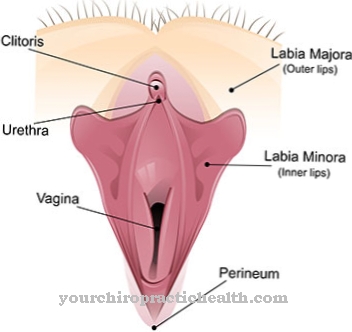The Diaper rash is common among babies. Appropriate behavioral measures can help prevent diaper rash.
What is diaper rash?
In the Diaper rash it is a skin disease that is inflammatory. The term diaper rash is made up of the Greek words for skin (derma) and for inflammation (-itis).
Diaper rash occurs predominantly in babies and toddlers who are still wearing diapers. Symptoms of diaper rash include sore or itchy reddening of the skin in the area covered by the diaper. In diaper rash, it is also possible, for example, for blisters or pustules to form, which can ooze. In addition to babies and toddlers, adults who wear diapers for incontinence can also be affected in comparatively low numbers by diaper rash.
In early infancy, diaper rash is a very common disease; According to statistics, almost every baby is affected at least once by a more or less severe form of diaper rash.
causes
When creating Diaper rash Different causes play together: First of all, the warm and humid environment that prevails under a diaper encourages the spread of germs within the area covered by the diaper.
In addition, the development of diaper dermatitis is promoted by the fact that the protective horny layer of the skin is damaged by the prevailing heat and moisture in the diaper area. In the run-up to diaper rash, this damage can mean that harmful substances can more easily penetrate the skin. Such substances that cause diaper rash come from urine (such as ammonia) and feces, for example.
Various diseases of an affected infant, skin irritation from diapers that are too tight, allergies or a weakened immune system are possible causes for the development of diaper rash.
Symptoms, ailments & signs
Diaper rash is primarily characterized by skin irritation in the areas that come into contact with diapers. These are mostly sore baby bottoms. Mainly newborns in the first three months of life are affected. Nevertheless, diaper rash can develop at any age in people who suffer from faecal or urinary incontinence and have to wear diapers.
The affected area of skin appears indistinctly red. The erythema on the buttocks begins to wet. Papules (skin nodules) and pus vesicles often appear at the edge of the rash. In some cases, the pustules can spread further to the inner thighs, abdomen, or lower back. If there is also a fungal attack, the symptoms worsen.
The itchy skin becomes unbearable. Burning pain can also occur. The skin is then much more reddened than with simple diaper rash. The sharply delimited edges are noticeable through fine scaling. In the event of an additional infection with streptococci or staphylococci, greater tissue damage can occur.
In these cases, large blisters often form, which can even lead to skin peeling. Fever is less common and the rash spreads to the entire body. Then a so-called bark lichen (pus lichen) can also form, which leads to a yellowish scab on the skin after it has burst and healed. Diaper rash usually heals within a short time without any consequences.
Diagnosis & course
One is diagnosed Diaper rash usually initially due to the skin rash typical of the disease. Typically, when diaper rash is present, the rash extends from a patient's buttocks to the lower abdomen and genitals.
The thighs can also be affected by the rash that occurs with diaper rash. In a further step, it is usually necessary to rule out other diseases that may be hidden behind an existing rash. Possible diseases that cause symptoms similar to diaper rash include neurodermatitis, allergies or psoriasis.
With early and appropriate treatment of diaper rash, in most cases the disease takes an uncomplicated course; healing is then possible within a few days. Occasionally, diaper rash can cause complications; for example, diaper rash can occur repeatedly. Very rarely, diaper rash can also extend beyond the diaper area.
Complications
Normally, diaper rash heals quickly with appropriate measures. Occasionally, however, complications can arise if, for example, there are several relapses and the skin is irritated again and again. Diarrhea or antibiotic therapy can aggravate the harmless clinical picture.
If relapses occur again and again despite suitable treatment methods, it is advisable to consult a doctor in order to rule out possible allergies, a weak immune system or other diseases that can promote inflammatory processes. Another possible complication of diaper rash is that the rash can spread to other areas of the body, and the rash can also show up on the face, head, or arms and legs.
In rare cases, it can also spread to the whole body and cause scaly reddening of the skin everywhere. If a skin fungus is triggered due to the diaper rash and treatment with cortisone is carried out, the skin in the affected areas can become thinner and thus react even more sensitively to irritation. A fungal disease can also promote diaper thrush and spread to the intestines.
When should you go to the doctor?
If there are changes in the appearance of the skin in the area of the abdomen in babies, children or people who have to wear a diaper, these must be observed further. In many cases, a change and optimization of the hygiene in dealing with the wearing of the diaper is sufficient to achieve an improvement in the overall situation. The irritation of the skin can be treated independently by changing a diaper more often or applying creams and care products for relief.
Normally, even without a doctor's consultation, there is significant relief or freedom from symptoms if body hygiene is improved. If there are long-term impairments or if there is a sudden increase in symptoms, it is advisable to consult a doctor. If the changes in the complexion spread further, if pain occurs or pus vesicles develop, action is required. Itching and open wounds must be assessed by a doctor. If there is a fever, general malaise or a feeling of illness, a doctor's visit is necessary.
Medical care should be initiated to avoid complications or secondary diseases. If skin changes occur in the area of the thighs, the back or the abdomen, this is considered worrying. Consultation with a doctor is required for a diagnosis. If there are problems with locomotion, the person concerned also needs medical help.
Treatment & Therapy
As part of the therapy of a Diaper rash the factors that have favored the development of diaper rash are usually combated first. In the case of diaper rash, for example, it is recommended to prevent the build-up of moisture and heat as well as friction caused by unsuitable diapers.
In order to ensure the above, in diaper rash, for example, disposable diapers that are air-permeable can preferably be used. In the case of diaper rash, experts also recommend changing diapers frequently. If possible, it can have a positive effect on the control of diaper rash if an affected baby or toddler can spend some periods of the day completely without diapers.
In various cases, in addition to combating the causative factors of diaper rash, additional symptom treatment may also be necessary. This can happen, for example, if diaper rash shows an infection caused by bacteria or fungi. A corresponding infection in connection with the diaper rash can be treated after consultation with the doctor, for example by giving antibiotic or antimycotic (fungus-fighting) drugs.
prevention
One can be bent forward Diaper rash above all by avoiding factors that can promote the disease. Accordingly, one factor that can prevent diaper rash is, for example, preventing excessive heat and moisture in the diaper area. It also makes sense to avoid skin irritation. In addition, protective lotions can reduce the risk of germs entering the skin and subsequent diaper rash.
Aftercare
Since diaper rash usually subsides quickly with consistent care and use of prescribed medication, no separate aftercare is required. Accordingly, diaper rash is not a disease that requires long-term therapy. Rather, diaper rash is a temporary, local skin irritation that is not contagious and in which blood values usually do not play a role.
However, separate follow-up care for diaper rash may be necessary if it is a possibly chronic course. This can occur if the skin is so irritated by constant inflammation that the dermatitis no longer subsides and secondary diseases such as fungi and a weakened immune system occur. In such cases, the skin must be examined regularly by a specialist after the acute symptoms have subsided.
The aim here is to ensure that the prescribed medication works or, if necessary, can be adapted to the complexion. In the area of aftercare, the main aim is to prevent the threat of chronification. However, these are exceptional cases and not the typical diaper rash that affects most babies at some point in their lives during the diaper period.
You can do that yourself
As a rule, diaper rash can be treated very well yourself with home remedies and special measures. Basically, it is advisable to do without the diaper at times if that is possible. The affected children should ideally be laid naked on a blanket in a heated room for at least one hour a day. Older children should be allowed to run around naked a lot. This is particularly recommended in summer. This way, fresh air gets on the irritated skin and the inflammation can heal faster.
Otherwise, the diapers should not be changed until they are full. It is better to change them at least after every meal. When changing diapers, the bottom should be cleaned with a warm washcloth and oily towels. The area should then be dabbed and ideally blown dry. On the one hand, it must be ensured that it does not get too hot. On the other hand, male children must be placed on their stomachs so that no stream of urine can get into the hairdryer.
Creams containing zinc can speed up healing. Baby powder, on the other hand, should never be used. In some cases it can help to use a different brand of diaper. Disposable diapers are generally more suitable than cloth diapers.


.jpg)



.jpg)










.jpg)







.jpg)


